REVEALED: eBooks are 8% cheaper on average than paperback copies

New research from leading UK mobile reseller, Buymobiles looks at why more people are moving from traditional print books to digital eBooks.
The study found that there has been a huge uptake of people reading digitally on their smartphones and tablets with eBook sales rising 23% in 2020 and print sales falling by 17% in the same period.
One reason for this is the cost of both. eBooks are 8% cheaper on average than their print edition equivalents – £3.06 compared to £3.30.
Another rationale for the uptake is convenience. Mobiles and tablets now offer an abundance of storage, with the latest iPhone 13 Pro and 13 Pro Max boasting up to 1TB, meaning consumers can store as many books as they want to read at their leisure.
There are also a number of other features that eBooks give users such as read-aloud mode, sharable content, easy updates to books when publishers/authors make edits and the environmentally friendly nature as opposed to print editions.
All the major mobile manufacturers also offer versions of their devices with larger displays, meaning users can comfortably read for hours without straining their eyes.
Models like the iPhone 13 Pro Max, Samsung S21 Ultra and the Google Pixel 6 Pro all offer around 6.8-inch screens, fantastic battery life and unprecedented brightness levels – the Samsung S21 Ultra in particular with a maximum of 1500 nits.
The South Korean tech giants also launched the Galaxy Z Fold 3 earlier this year, which has one of the largest screens on the market at 7.6-inches, perfect for eBook consumers.
The ‘reading mode’ feature has also helped improve the user experience with digital books, softening the blue light on devices and maximising the display size to accommodate text.
It comes as standard on Apple iPhone devices but loads of free apps are available for Android phones such as Blue Light Filter and Night Shift, which are among the top-rated and do the same thing as Apples’ built-in reading mode feature.
Pavlina Kostarakou, CEO and founder of specialist reseller Diavazo Greek Bookshop, commented on the rise of smartphone readers, saying, “Our phones are powerful tools that combine a multitude of features.
“Reading on them makes total sense for people who want to have everything combined on one device and people that don’t want to or can’t afford to buy a separate device just for their e-books.
“Plus, there are quite a few apps that help download and store eBooks and audiobooks which are mainly designed for phone and tablet UI than for any other device so that immediately narrows down the means of usage.
“Therefore, the convenience for those who are pretty comfortable reading on any screen is too great to refuse – and more and more people are comfortable with that as we all spend a significant amount on our phones every day anyway.”
Despite highlighting many advantages of eBooks, she does not see print copies dying out anytime soon; “As a bookseller, I don’t see that happening exclusively (users only reading eBooks and not buying print editions), at least not in the near future.
“This is not my wishful thinking, but because I see, first of all, the firmness in the decision of the people who prefer to buy physical copies instead of electronic ones and their main reasons of doing so: reducing their screen time, disconnecting from the continuous phone usage, creating a ritualistic contact with their books and their reading time.”
Jess Canning, Mobile Phone Expert at Buymobiles also commented on the research saying, “We knew that eBooks were becoming more and more popular over the last few years but had no idea just how many people were switching over from traditional print editions.
“It’s clear to see that the industry has adapted to this by offering features like reading mode and bigger versions of devices to accommodate users’ increased screen time.
“The price comparisons were also interesting to see and while it might not seem like much, you also have to take into account the convenience factor of having hundreds of books in the palm of your hand as opposed to the huge amount of space a comprehensive print collection would take up in a consumers’ home.”





